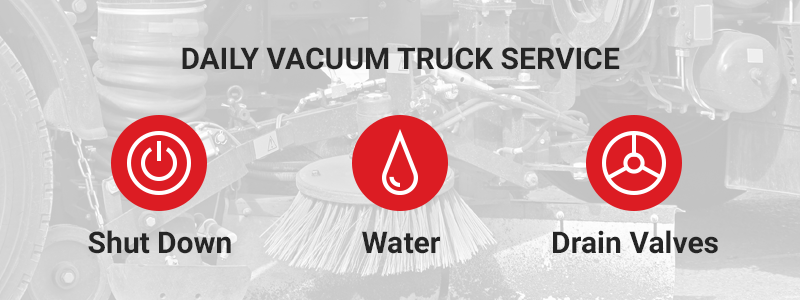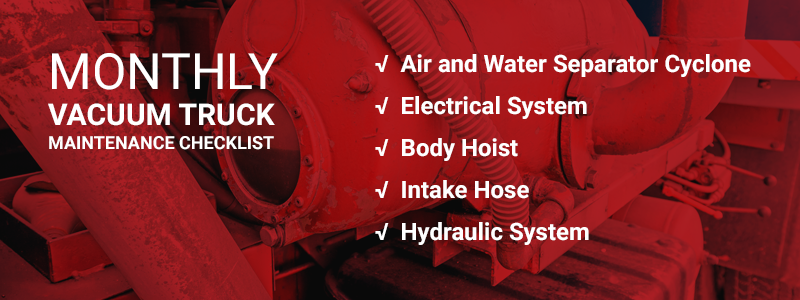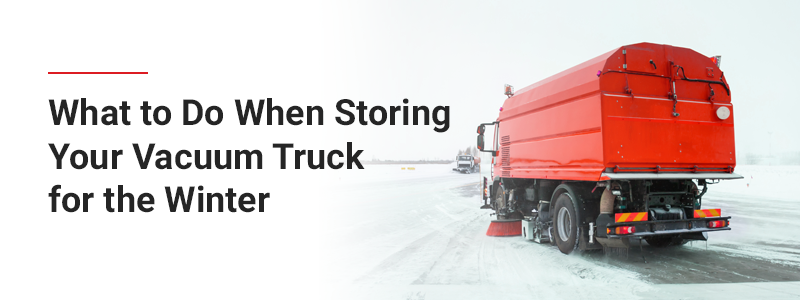Buying a high-quality vacuum truck is only half the battle for any owner. The other half involves maintaining your truck at peak efficiency. This process means regular maintenance checks that depend on the day, the week, the month or even the year. Regular maintenance means a long life for your vacuum truck and durable, long-lasting components that avoid wear and tear and corrosion.
Think about how you treat your car. You know that if you want to keep it on the road for a long time, you need to change the oil every 3,000 to 5,000 miles depending on the type of car and the type of oil that you’re using. You want to take it to the shop every time the check engine light comes on. You take it in for a yearly inspection to make sure all the lights are working, the exhaust system is intact and it’s good to go for another year.
You need to treat your vacuum truck the same way. Imagine you’re driving a Lamborghini. Your vacuum truck is a lot tougher and designed to deal with a much heavier workload than any sports car, but if you pamper your vacuum truck the same way the owner of a Lamborghini pampers their car, it’ll be on the road long after any expensive sports car has made its way to the junk heap.
Let’s start with daily maintenance.
Daily Vacuum Truck Service
Three important tasks need to be performed on a daily basis:
- Shut down: Shutting down a vacuum truck at the end of the day means more than just turning the engine off. If you want to make sure your truck continues to perform at a high level, you need to shut it down properly.
- Open drain valves: You want all the water out of your water system every day. Open all the drain valves to ensure this happens. Doing so will allow debris to free itself from the internal system, and it also improves air circulation.
- Double check for water during long-term storage: Once you’ve taken the most important step by opening the drain valves, you’re not done. If you’re looking at storing your truck for the winter, you’ll want to make sure there isn’t a drop of water in your internal systems. Even a little water will freeze, which might damage important components. It’s also a good idea to properly lubricate the truck and check your fluids.
Weekly Truck Maintenance
It’s crucial to perform these maintenance checks weekly because problems with your fluid or air breather can lead to a world of trouble, mostly financial in nature:
- Maintain fluid levels: First, all the cylinders should be in the retracted position. You want to watch your fluid level closely. If any reads low, refill it right away — including fluid in the hydraulic tank or oil in the blower. If they continue to show low readings, it could be a sign that you have a leak somewhere. You won’t know about leaks unless you’re consistently checking your fluid levels.
- Check on the air breather: Like fluid levels, this component should probably be checked at least twice a month.
- Clean the debris body: Check about twice a month. Use a water handgun, and start at the front. Work your way to the back on one side, and then do the same thing on the other side. If you can, clean out the sludge pump, and make sure the debris football is free of waste. After that thorough cleaning, start the engine and run the truck for five to 10 minutes to dry out any moisture that might be in the body.
Monthly Vacuum Truck Maintenance Checklist
Now, we move on to dealing with maintenance tasks that should be done monthly. And when we say monthly, we mean monthly. These aren’t things that can be done in June and then again in August. You need to do them in June, July and August too:
- Inspect the air and water separator cyclone: Properly clean the screens. The air access areas should be checked, and you should remove any dirt or debris from the broom enclosures. Then, coat the inside edges with a light application of grease. Make sure the connections between the intake couplers, ball joints and other areas are tight. Loose connections reduce blower efficiency.
- Look at the electrical system: Look for loose, frayed or damaged wires. This area is one where preventive maintenance can pay big dividends. You don’t want to find out in the middle of a job that there are problems with your electrical system because of a loose wire. Checking your electrical system on a monthly basis will prevent these problems.
- Maintain the body hoist: Regularly inspect upper and lower trunnion ends on the cylinders, lifting levels, frame, valve, cross shafts and pump. Look at your hose lines for damages, and make sure hose ends are tight. Take a look at the cylinder packing, at the pins for long-term wear or possible holes and at the mounting bolts for loose connections.
- Check the intake hose: Since these hoses are made of rubber and fabric, you should inspect for signs of wear. You can even help reduce wear with a few easy tricks. To minimize wear in one particular area, rotate the hose occasionally. You can rotate it to either 180 degrees, 90 degrees or even-to-end if that suits your purposes. If you spot any minor cracks or leaks, repair them if possible as soon as you can.
- Service your hydraulic system: Certain maintenance tasks need to be done only yearly, but if you’ve noticed you’re having some problems with your hydraulic system, you’ll find that they can almost always be traced to contaminants in the hydraulic fluid. Never allow foreign matter to make its way into your hydraulic fluid. It leads to malfunctions, sludge accumulations and serious wear.
Remember these hydraulic system servicing tips:
- If you’re seriously concerned about your hydraulic fluid, you can either send it to a commercial lab for testing or do-it-yourself. If you’re going to send it to a commercial laboratory, take a sample from the center of the reserve when it’s at operating temperature. Place the sample in a glass bottle with a screw-on lid. Write the date, the type of fluid and the model and the serial number of your machine on the lid. Send it to the lab.
- If you’re going to do it in-house, once you’ve taken the sample, set it aside for half an hour to rid it of air bubbles. The first check is a simple one — hold it up to the light to see if there’s any debris. If you see some, that’s a sign of a serious contamination problem. If the fluid looks cloudy, it’s likely water contamination.
- In-house, you can also do a blotter test to check for oxidization. Put a drop of fluid on blotter paper. If it’s colorless, you have no problems with oxidization. If you see color, but the color is uniform, the fluid is okay, but you should check to make sure it has the correct additive content. If the blotter shows distinct rings from the fluid drop, change it right away.
Yearly Vacuum Truck Maintenance
While these particular maintenance tasks only need to be done once a year, that doesn’t make them any less important than the ones on your weekly or monthly vacuum truck checklists:
- Change hydraulic filters: You need to change your hydraulic filters at least once a year — and doing it twice is an even better idea. Throw the old filters out, and put new ones in. Make sure you refill the new filters with the correct kind of hydraulic oil.
- Flush the hydraulic system: Do this while you’re in the process of changing your filters. Just remove the drain plug, and drain all fluid from both the tank and the fluid reserve. Once you’ve drained the old fluid, replace the plug, and fill with fresh fluid. Start up the truck, and check all of your hydraulic systems. Put the cylinders in the retracted position, and turn off the truck. Now, re-check the fluid levels, and add whatever fluid is needed to bring levels back up to at least the halfway point in the site gauge.
Use flushing the hydraulic system as an opportunity to put in a new hydraulic tank breather.
What to Do When Storing Your Vacuum Truck for the Winter
So you’ve been an attentive owner and made sure that all your weekly, monthly and yearly vacuum truck maintenance checklists have been followed. Your machine is operating better than ever, and you’re getting lots of work done. But winter is on the horizon, and you’ll need to store your truck for a few months. There are just a few more things to do before you put it away for the winter:
- Steam clean the inside of the body: A good steam clean will remove any foreign objects or debris that you don’t want hanging around for several months when you’re not using your machine.
- Repaint the inside with a good primer: This process reduces moisture and helps prevent corrosion in important components like the air chamber.
- Rotate the blower by hand every month: To a large degree, this need depends on in your situation. If you don’t need to do it, don’t do it. But if you think it helps keep your vacuum truck stored properly, don’t hesitate.
Let Southern Vac Help You With All Your Vacuum Truck Needs
At Southern Vac, our priority is our customers and our relationships with them. Their satisfaction is what drives us to do our very best every day. We take pride in the fact that our manufacturers are the best in the industry. That means we can offer superior equipment and parts. We have the largest stock inventory and rental fleet in the entire Southeast.
Whatever you need, we can offer immediate delivery. You’ll receive above average service from our knowledgeable and expert team. If you have stormwater, sewer or street maintenance needs, you’ll find that we’re committed to giving you the very best service available. No job is too little or too big, because we want to be the partner you can trust to help you get the job done. We separate ourselves from the competition by delivering on-site service, loaner machines and rental options for our customers.
If you’re in the neighborhood, come and visit us at either of our convenient locations or give us a call at 803-358-0221. Want to drop us your information instead? Contact us here, where you can fill in some details about yourself and your specific needs. A member of our team will get back to you right away!




